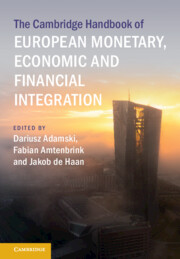Book contents
- The Cambridge Handbook of European Monetary, Economic and Financial Integration
- The Cambridge Handbook of European Monetary, Economic and Financial Integration
- Copyright page
- Contents
- Contributors
- Introduction
- Part I The Economic and Monetary Union
- Part II The Monetary Dimension
- Part III The Economic and Fiscal Dimensions
- 15 Reviving the Case for Policy Coordination in EMU
- 16 Ten Years of the European Semester
- 17 The EU Fiscal Rules
- 18 National Fiscal Policy in EMU
- 19 The Politics of Fiscal Integration in Eurozone Reforms and Next Generation EU
- 20 Adjustments in Economic Crises
- 21 Designing a Permanent EU-Wide Stabilization Facility
- 22 Enhancing Private and Public Risk Sharing
- Part IV Financial Integration
- Index
- References
16 - Ten Years of the European Semester
From the Sovereign Debt Crisis to the COVID-19 Crisis
from Part III - The Economic and Fiscal Dimensions
Published online by Cambridge University Press: 28 September 2023
- The Cambridge Handbook of European Monetary, Economic and Financial Integration
- The Cambridge Handbook of European Monetary, Economic and Financial Integration
- Copyright page
- Contents
- Contributors
- Introduction
- Part I The Economic and Monetary Union
- Part II The Monetary Dimension
- Part III The Economic and Fiscal Dimensions
- 15 Reviving the Case for Policy Coordination in EMU
- 16 Ten Years of the European Semester
- 17 The EU Fiscal Rules
- 18 National Fiscal Policy in EMU
- 19 The Politics of Fiscal Integration in Eurozone Reforms and Next Generation EU
- 20 Adjustments in Economic Crises
- 21 Designing a Permanent EU-Wide Stabilization Facility
- 22 Enhancing Private and Public Risk Sharing
- Part IV Financial Integration
- Index
- References
Summary
This chapter traces how the European Semester – its policy goals, institutions, and legitimacy – have changed over the decade 2011–21. Drawing on the most recent political science scholarship, the chapter makes a three-fold argument. First, it argues that the Commission has travelled a long way from pushing fiscal consolidation and structural reforms through enforced fiscal and macroeconomic policy surveillance to emphasizing social investment. Second, the chapter challenges the widely held notion that the Semester suffers from limited effectiveness and argues that its country-specific recommendations can have indirect effects in the longer term, such as putting new issues on the agenda and shaping national policy debate. However, the chapter expects that the Commission’s influence over national policy processes will rise in the post-pandemic period through the conditionality of the Recovery and Resilience Facility. Third, the chapter argues that representation of broad social interests changes over time. Social partners, civil society, and national parliaments may be excluded from EU economic governance processes but tend to adapt to EU institutional changes over time.
- Type
- Chapter
- Information
- Publisher: Cambridge University PressPrint publication year: 2023

